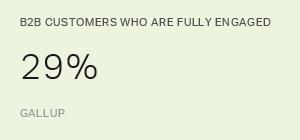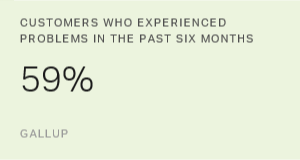Story Highlights
- The global data push is stronger than ever
- Data-driven companies are more productive and profitable
- Leaders need to develop and sustain a data-driven culture
The data movement is growing exponentially, not only regarding the sheer quantity of data but also in the ways companies use data for strategic decision-making.
International Data Corporation estimates that global data doubles in size every two years and that by 2020, it will reach over 44 trillion gigabytes -- increasing tenfold from 2013.
In tandem with the data explosion, a growing digital economy and advances in data science dramatically amplify the analytic value of big data. As a result, companies can better connect data for greater predictive power and high-impact insights.
Business use of predictive analytics is on the rise because many companies recognize the competitive advantage that data and analytics can offer to their decision-making. According to one estimate, companies in the top third of their industry for data-driven decision-making are 5% more productive and 6% more profitable than their competitors. Predictive analytics enable leaders to make radical discoveries about their companies and dissect and solve complex business problems, thereby enabling better business strategies and performance.
Before companies can capitalize on predictive analytics, they need a workplace that enables the use of the right data, analytic sciences and a culture that empowers employees to identify and understand data-driven discoveries, and then make the right decisions based on those discoveries. The challenge in creating that workplace is bridging the gap between trillions of gigabytes of data and the heart of every business: its employees. Moving from bytes to insights is easier said than done, and many leaders strive to build a data-driven workplace but don't know how to get there. According to one KPMG study, more than half of executives (54%) say the top barrier to success is identifying what data to collect, and 85% say they don't know how to analyze the data they have collected.
Business leaders are facing a mounting data and people challenge. Predictive analytics are powerful when a company collects the right data and then its employees interpret and apply data-driven discoveries to drive growth. Companies that seek to generate meaningful business insights need to shift from bigger to better data and balance analysis with perspective. This change requires building a best-in-class data experience by collecting the right data, leveraging analysis to make the most of the data and developing a culture capable of integrating insights into day-to-day business processes and decision-making.
The Right Data to Drive the Right Insights
Before they can begin the analysis process, companies need to identify, evaluate and incorporate the data that are most informative and valuable for their future growth. This process can pose significant challenges because it's increasingly difficult for leaders to ascertain on which of their many data sources to focus to solve business problems and glean the most powerful strategic insights. Companies need a foundation of reliable, rich data to make well-founded decisions.
First, companies need to determine which combination of organizational data, primary research and alternative -- or third-party -- data will best inform their business needs. Leaders also need to define their data curation process, including sourcing, evaluation, cleaning, storage and maintenance.
One global high-tech manufacturer faced and solved the "right data" dilemma. The company's product was positioned at the start of the supply chain and required lengthy production times, so the company needed an accurate forecast of its end-consumer demand to adjust its operations planning and budgeting quickly. However, executives struggled to anticipate significant shifts in consumer demand due to a highly volatile emerging market and an over-reliance on internal operations, inventory and sales data. They needed to analyze consumer data earlier to adjust their operations accordingly.
The company solved this problem by incorporating additional data sources and predictive elements, such as web search trends, macroeconomic data and Gallup proprietary data on consumer economic perspectives and spending patterns, into their analyses. By focusing on expanding its data sources to capture the right data that had the most predictive power, the company improved forecast accuracy by over 150%.
The Right Analysis to Solve Crucial Business Problems
Once companies have the right data, they need to determine the appropriate analytic sciences and systems based on their business needs. For example, commercial analytics, such as consumer demand or pricing optimization studies, might be an ideal focus for a company evaluating its product pricing strategy. Another business may benefit from people analytics, such as turnover risk management or recruitment optimization studies, while a growing department within the company may urgently need operations analytics, such as new product planning studies.
Leaders need to ensure that their company's analyses and processes are well-aligned, by using analytics activities to redefine decision structures, processes and rituals, rather than incorporating analytics into existing processes. A thoughtfully selected, well-integrated analysis provides decision-making support on crucial business problems and helps businesses improve their operational effectiveness.
The Right Culture for Business Integration
Many companies -- whether they are just beginning their analytics journey or are well on their way -- are discovering their cultures are not prepared to manage and apply the massive influx of information. According to one estimate, 60% of big data projects will fail to go beyond piloting and experimentation due to culture issues.
To turn data into improved operational effectiveness, companies need a data-driven culture that sends insightful, well-aligned messages to employees and supports meaningful employee actions. If workers lack direction and don't know what actions to take -- or if the right processes aren't in place to enable employees to make improvements -- data initiatives will stall. The right culture starts with the C-suite: Leaders need to support and prioritize a data-driven culture by following a clearly defined strategy for building and sustaining it.
Another smart move for fostering a data-driven culture is understanding a company's analytics readiness, or how well its data systems, processes and people are aligned. This in-depth perspective on the analytics health of the business -- along with insights on how to accelerate the growth of a data-driven culture -- can enable leaders to optimize and advance analytics for their company.
Managing the Full Analytics Life Cycle
One global services company conducted this type of data experience audit after investing in new data and analytics technologies and creating a new data science business division. Unfortunately, three out of five leaders with the company said they still did not get the analytics they needed to make good decisions. Though leaders believed the company's data, technology systems and data science capabilities lagged behind industry standards, the data experience audit showed the company's more pressing problems were communication and process management. The company lacked the ability to manage the full analytics life cycle from request to decision-making to set its analytics work up for success.
To correct these problems, the company readjusted its focus, launching a change management initiative that better aligned its leaders' and data science team's expectations, capabilities, decision-making protocols and accountability systems. The result was increased adoption of analytics in strategic decisions.

